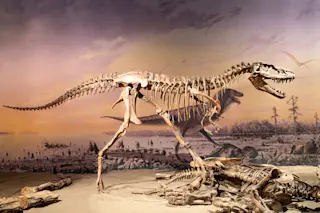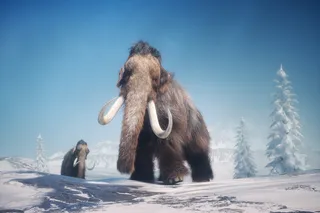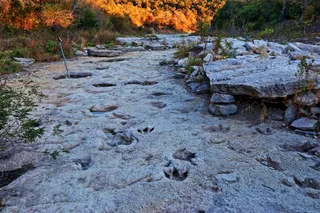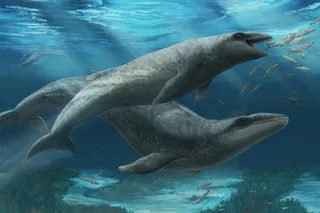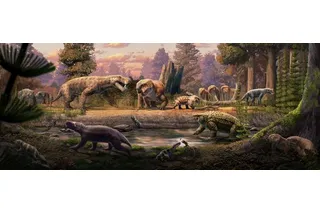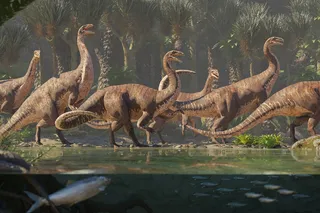Apparently adolescent tyrannosaurs took the term “baby food” a bit too literally. According to a report in Science Advances, researchers recently analyzed the stomach contents of a teenage tyrannosaur for the first time. Finding some of the first fossil support for the tastes of these predatory youngsters, the analysis revealed that tyrannosaur teens made meals out of other baby dinosaurs.
What Did Young Tyrannosaurs Eat?
Up until 2023, the habits of juvenile tyrannosaurs were mysterious. It is well-established that tyrannosaur adults hunted large herbivores such as triceratops and other horned dinos, according to scrapes and bites on fossilized bones. But there is little fossil evidence for young tyrannosaurs.
What Was in the Stomach of the Young Dinosaur?
The analysis of a young tyrannosaur specimen from the collections of the Royal Tyrrell Museum of Palaeontology in Alberta, Canada, recently changed all that, attesting to the specific feeding patterns of juvenile tyrannosaurs for the first time.
Active approximately 75 million years ago, the analyzed dinosaur — a juvenile Gorgosaurus libratus specimen with well-preserved contents in its stomach cavity — died in what would’ve been its adolescence, at around 5 to 7 years old. At the time of its death, the teen would’ve weighed around 740 pounds, or 13 percent of the weight of an adult of the same species. And inside its stomach sat the fossilized appendages of two Citipes elegans dinosaurs, both younger than one years old.
In their Scientific Advances report, the researchers write that the tyrannosaur specimen represents “the first instance of in situ stomach contents,” for a tyrannosaur, adolescent or adult, “preserved in their proper anatomical position” in the abdomen. The tyrannosaur’s skeleton, and the bird-like babies it ate, provide “direct fossil evidence of diet and feeding behavior in a young tyrannosaurid,” indicating that they dined on tiny dinos younger than themselves.
Read More: Dinosaur Dimensions Weren’t One-Size-Fits-All
How Big Were the Tyrannosaurs?
Among the largest land predators to ever exist, the tyrannosaurs of the Tyrannosauridae family terrorized the Northern Hemisphere from around 80 million to around 66 million years ago.
Famed for their stunning growth spurts and their spots at the top of their terrestrial ecosystems, the tyrannosaurs — like the terrible Tyrannosaurus rex and the terrifying Tarbosaurus bataar — experienced major morphological transitions throughout their lives, transforming from small, slender adolescents into big, bulky adults.
Stretching from lengths of around 3 feet to around 30 to 40 feet as they aged, it seemed likely that the tyrannosaurs’ favorite foods shifted as they aged. Yet researchers lacked the fossil support for this shift until the recent study, struggling to differentiate the feeding strategies of tyrannosaur juveniles and adults.
Read More: The Time of Giants: How Did Dinosaurs Get So Big?
Two Baby Dinosaurs
Found in Alberta in 2009, it wasn’t until recently that the tyrannosaur specimen’s stomach contents were fully assessed.
According to their analysis, the position and the degree of digestion of the two baby dinosaurs suggest that they were devoured at different times, indicating that the young tyrannosaur targeted tiny, infantile prey on at least two separate occasions.
“With two animals of the same species, age, and size ingested in separate events, the stomach contents suggest that the juvenile Gorgosaurus may have preferentially preyed upon [the] young-of-the-year,” the researchers write in their report. “The current discovery, albeit a single specimen, reveals that this juvenile Gorgosaurus had hunted small prey.”
Tiny Teeth For Tiny Food
This preference for small food fits with modern understandings of tyrannosaur morphology, the researchers assert. While juveniles were slender, with smaller skulls and thinner teeth, adults were robust, with massive skulls and thick teeth. The former allowed adolescents to tear into their tinier prey, while the latter helped adults restrain much more massive animals, biting through bone and removing bigger bits of flesh.
Read More: Tyrannosaurus Teeth Were Hidden Behind Lizard-Like Lips
Tyrannosaur Food For All: Adolescents and Adults
According to the researchers, their report reveals that the tyrannosaurus were versatile, voracious predators throughout their lives. The dinosaurs pursued prey that was not only suitable for their size, but fit for supporting a thriving, well-balanced tyrannosaur population.
“Dietary shifts provide a competitive advantage,” the researchers conclude in their report, “as it can lessen intraspecific competition for resources.” Diversifying their food sources according to their specific stages of life, the distinct, adolescent diet of the tyrannosaurs “may have allowed juvenile and adult tyrannosaurids to coexist in the same ecosystem with limited conflict.”
Read More: Massive, Dead Dinosaurs May Have Made Scavenging Irresistible



